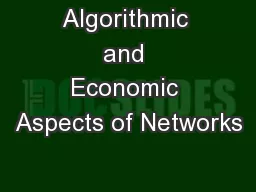

Nicole Immorlica Networked Markets Garmets Market Marseille Fish Market Labor Markets Why Network Trust predicability referrals incomplete contracts friction ID: 562859
Download Presentation The PPT/PDF document "Algorithmic and Economic Aspects of Netw..." is the property of its rightful owner. Permission is granted to download and print the materials on this web site for personal, non-commercial use only, and to display it on your personal computer provided you do not modify the materials and that you retain all copyright notices contained in the materials. By downloading content from our website, you accept the terms of this agreement.
Slide1
Algorithmic and Economic Aspects of Networks
Nicole ImmorlicaSlide2
Networked Markets
Garmets
Market
Marseille
Fish
Market
Labor
MarketsSlide3
Why Network
Trust, predicability, referrals,
incomplete contracts, friction,
moral hazard/adverse selection
price, reputationSlide4
Labor Markets
“You hear about jobs through your friends.”
– Granovetter
b
etterSlide5
Boorman’s Model
Network of
strong
and
weak
ties
Preferential flow
of information about job opennings through networkSlide6
Strong and Weak Ties
Weak +
λ∙
Strong = TimeSlide7
Information Flow
People need jobs with prob.
μ
.
People hear about jobs with prob.
δ
.
People tell (stronger) friends about jobs.Slide8
Boorman’s Results
Study trees, fix degree of strong/weak ties, consider equilibria via simulation
As cost of strong ties , # strong ties .
As unemployment prob. , # strong ties .Slide9
What’s Missing?
network architecture, e.g., weak ties more likely to be bridges
correlation in employment state over time and network structureSlide10
Carvo-Armengol & Jackson
Drop strong/weak distinction, but incorporate time.Slide11
Information Flow
People need jobs with prob.
μ
.
People hear about jobs with prob.
δ
.
People tell friends about jobs.Slide12
Tarred with the Same Brush
Time causes correlation in employment:
you are more likely to find a job if more of your friends have jobsSlide13
Persistance of (Lack of) Luck
The longer you are unemployed, the less likely you will find a job tomorrow:
because you are more likely to have more unemployed neighborsSlide14
Education
Agents can pay cost
c
i
to be educated.
educated
– apply previous model
uneducated – payoff zeroSlide15
Poverty Traps
Payoff: 0.5 –
c
i
Payoff: 0.6 –
c
i
Payoff: 0.69 –
c
i
Payoff: 0.65 –
c
iSlide16
Networked Exchange Theory
Network represents potential trades
what prices result?Slide17
Nash Bargaining
How to split a dollar?
Matt ($0.50)
Mykell ($0.50)
If negotiations fail, you get nothing.Slide18
Nash Bargaining
How to split a dollar?
Trevor ($0.70)
William ($0.30)
If negotiations fail, Trevor gets $0.60, William gets $0.20.Slide19
Nash Bargaining
Any
division in which each agent gets at least the outside option is an equilibrium.
Yet ….
a
gents usually agree to
split the surplus
.Slide20
Nash Bargaining
If when negotiation
fails
,
- A gets $a
- B gets $b
Then when
succeed, - A gets $(a + s/2) - B gets $(b + s/2)
s
= (1 – a – b
) is the surplusSlide21
Nash Bargaining
Nash
: “
Agents will agree to split the surplus
.
”
Motivated by axiomatic approach, optimization approach, and outcome of particular game-theoretic formulations.Slide22
Bargaining in Networks
Value of outside option arises as result of network structure.Slide23
Bargaining in Networks
William ($0.50)
Arun ($0.50)
Bach ($0)
Matt ($0)
Mykell ($0)
Transactions worth $1.
Only one
transaction per person!Slide24
Bargaining in Networks
Almost all the money.Slide25
Bargaining in Networks
v
v gets between 7/12 and 2/3 in negotiation to left.Slide26
Bargaining in Networks
v
v gets between 1/2 and 1 in negotiation to left.Slide27
Cook and Yamagishi
A solution for a network G is a
matching M
and a set of
values
ν
u
for each node u s.t., - For (u,v) in M, ν
u + νv = 1
- For unmatched nodes u,
ν
u
= 0Slide28
Stable Outcomes
Node u could negotiate with unmatched neighbor v and get (1 -
ν
v
).
Outside option of u is
α
u
= maximum over unmatched neighbors v of (1 - νv).Slide29
Stable Outcomes
Defn
. An outcome is
stable
if for all u,
ν
u
≥
α
u.
Notice there are many stable outcomes, so which one should we expect to find?Slide30
Balanced Outcomes
Each individual bargaining outcome should agree with the Nash bargaining solution.
s
uv
= 1 -
α
u
-
α
vνu
= αu + s/2
And similarly for
ν
v
.Slide31
Computing Balanced Outcomes
A balanced outcome exists if and only if a stable outcome exists.
Balanced outcomes can be computed and characterized using Edmonds-Galai decompositions.
[Kleinberg-Tardos STOC’08]Slide32
Assignment:
Readings:
Social and Economic Networks, Chapter
10
The two Kearns papers or a paper on labor markets of your choosing (see refs in book)
Reaction to paper
Presentation volunteers?